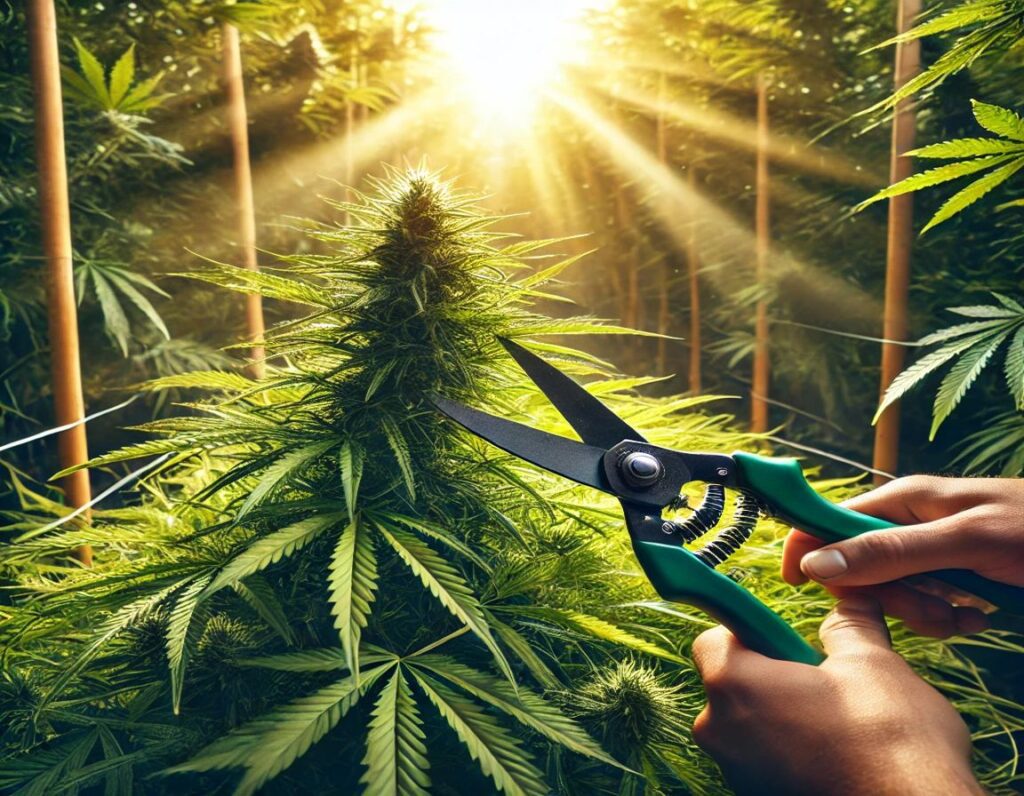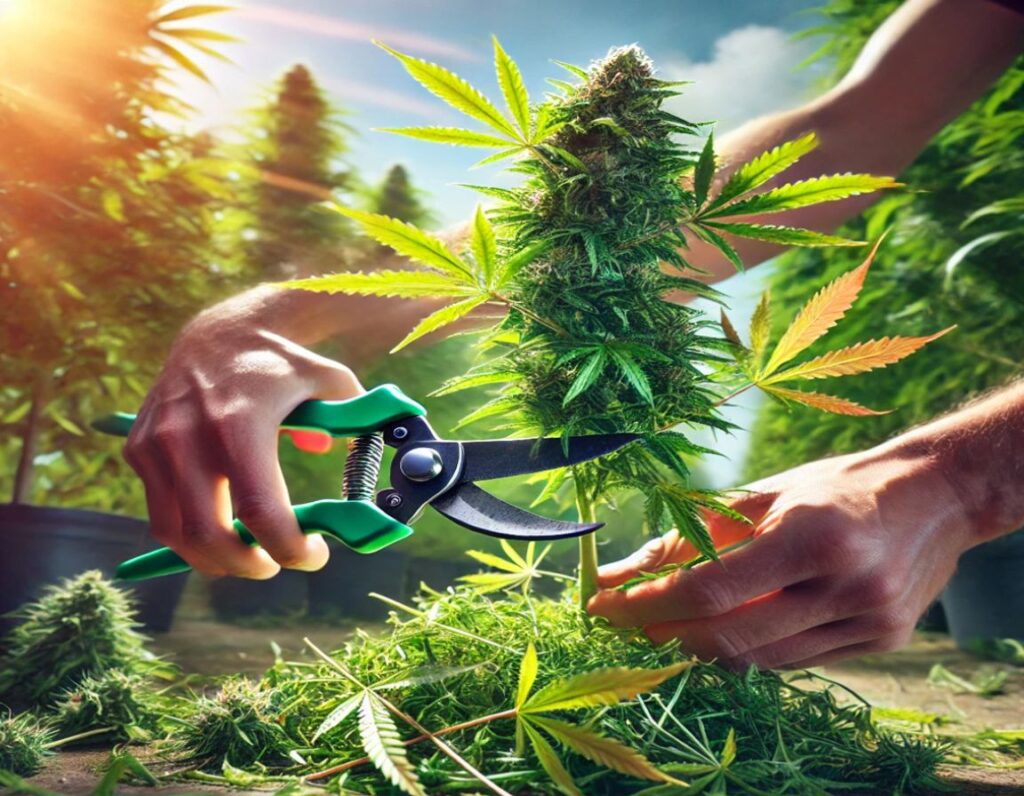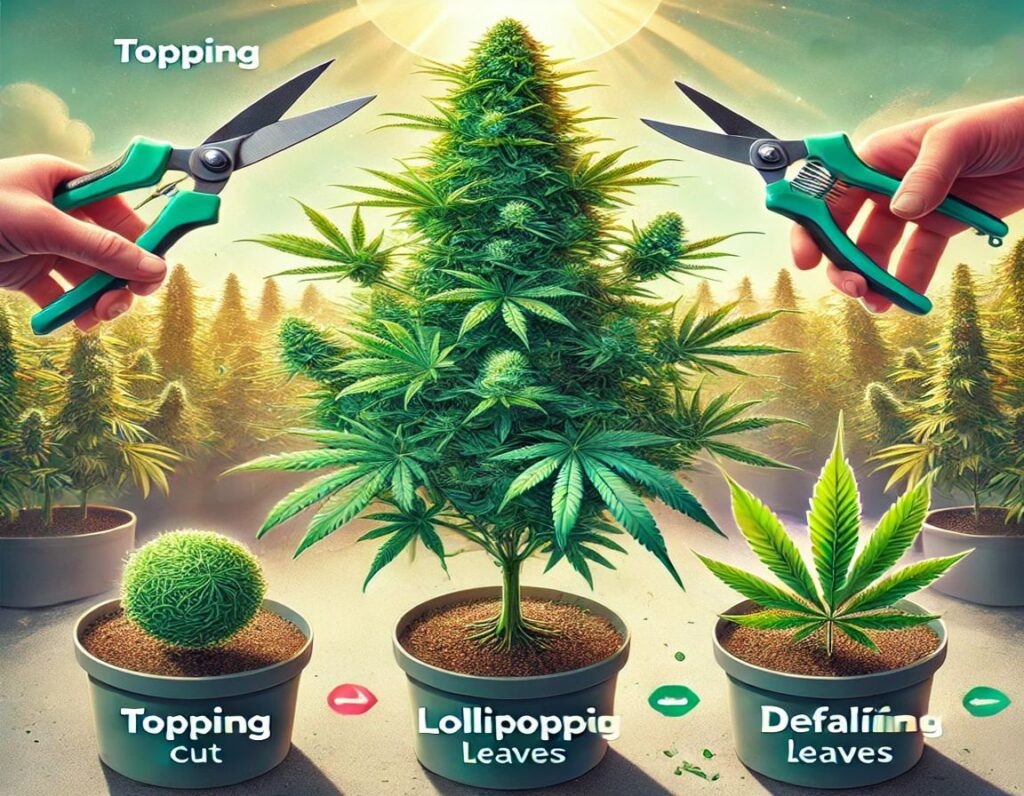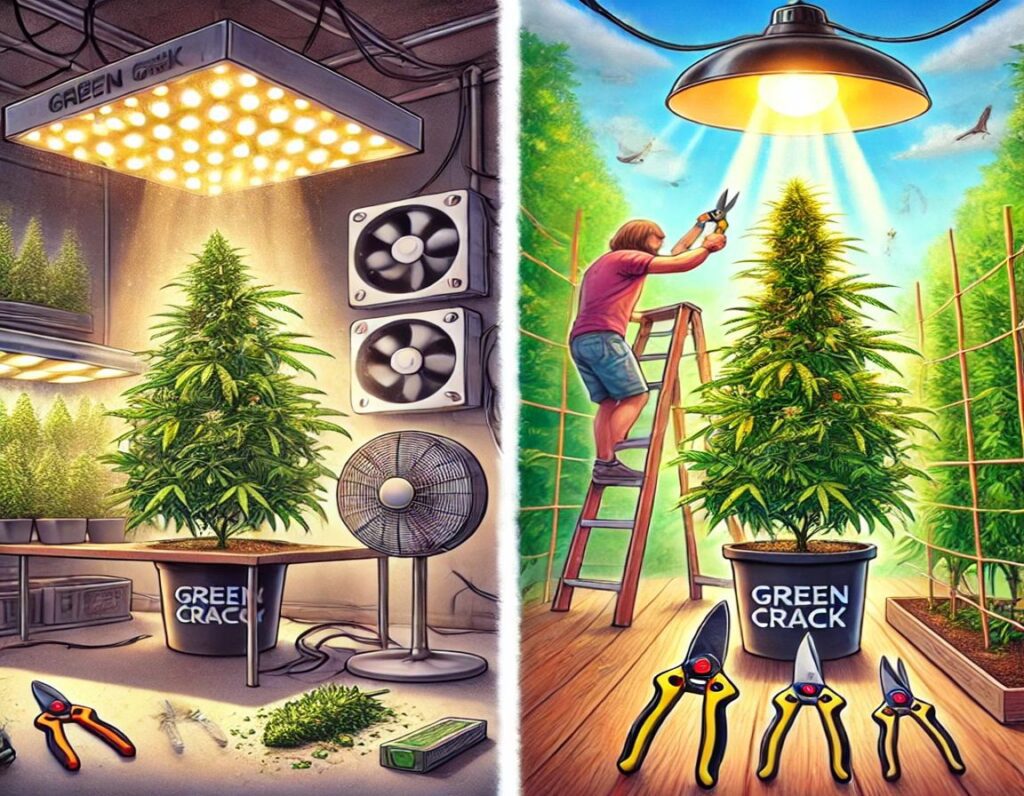
Pruning plays a critical role in optimizing the growth and yield of Green Crack cannabis plants. It enables growers to manage the plant’s energy by directing it toward producing healthy, dense buds, rather than sustaining unnecessary foliage. Pruning improves light penetration and airflow, which are essential factors for preventing mold and pests. In the USA, where Green Crack is popular among cannabis cultivators, pruning is especially valuable in regions that support outdoor growth, such as California, Colorado, and Oregon.
By carefully removing excess leaves and branches, you allow the plant to focus its resources on developing the main colas (flowering sites). This can significantly increase your final yield, particularly when pruning is done properly and at the right time. However, it’s important to prune strategically, as over-pruning can stress the plant and reduce its overall productivity.
Growers recommend starting with dead or yellowing leaves and any lower branches that don’t receive adequate light. These parts of the plant consume energy that could otherwise be directed toward the formation of larger, healthier buds.

Timing is crucial when it comes to pruning your Green Crack plants. Pruning should primarily be done during the vegetative stage because this is when the plant is growing vigorously and can quickly recover from cuts. The vegetative stage is characterized by rapid leaf and stem development, making it the ideal period for shaping the plant.
Start pruning when your plants have developed at least 5-6 sets of leaves. This indicates that the plant is strong enough to withstand the stress of pruning. At this point, you can begin by topping the main stem and removing any leaves or branches that appear unhealthy or unnecessary.
During the flowering stage, avoid heavy pruning. This is when the plant focuses on bud production, and pruning could divert its energy away from developing the flowers. Instead, limit pruning to light trimming, such as removing dead leaves or small branches that aren’t contributing to the plant’s overall health. This helps ensure that the plant’s energy is concentrated on producing larger, more potent buds.
Growers across the USA, particularly those in regions with longer growing seasons, often perform the majority of their pruning during the vegetative phase. This gives the plant time to recover and ensures that it is well-shaped before entering the flowering stage.

There are several effective pruning techniques that can enhance the growth and yield of your Green Crack plants. Each method serves a different purpose, but when used together, they can significantly improve your plant’s structure and output. Below are some of the most commonly used techniques:
Topping involves cutting off the top of the main stem, which encourages the plant to grow multiple colas instead of just one. This increases the number of main flowering sites and results in a bushier plant with more buds. Topping is typically done when the plant has developed at least 4-6 sets of true leaves. Many USA growers use topping early in the vegetative stage to maximize their plant’s yield potential.
This technique involves removing the lower branches and leaves that don’t receive much light. By clearing out the bottom part of the plant, you allow it to focus its energy on the upper buds, which receive more light and grow bigger. Lollipopping not only improves the plant’s focus on higher bud production but also enhances airflow, reducing the risk of mold and pest infestations.
Defoliation is the selective removal of large fan leaves. This technique increases light penetration to the lower parts of the plant and improves airflow. However, defoliation should be done cautiously to avoid stressing the plant. Removing too many leaves can hinder photosynthesis, so it’s important to strike a balance.
Similar to topping, fimming involves cutting about 75% of the main stem’s tip. The difference is that fimming encourages bushier growth without removing as much of the plant. Fimming is often used to create more bud sites, especially in plants that tend to grow taller.
USA growers often combine these techniques to optimize plant structure and boost yield. For example, topping followed by lollipopping can help shape a plant that produces dense, light-exposed buds.

Pruning offers numerous benefits, but it can also stress your plants if done improperly. Over-pruning or cutting too many branches at once can cause the plant to go into shock, slowing its growth and reducing its yield. To avoid this, it’s important to prune in moderation and give your Green Crack plants time to recover between sessions.
After each pruning session, closely monitor your plants for signs of stress. Common indicators include drooping leaves, slow growth, or discoloration. If you observe any of these signs, allow the plant time to recover before pruning again.
To further reduce stress, always use clean, sharp tools when pruning. Dirty or dull tools can tear the plant tissue, increasing the risk of infection. Make sure to disinfect your tools between uses to prevent the spread of bacteria or diseases.
Growers in different regions of the USA recommend pruning during the cooler parts of the day, particularly for outdoor grows, to reduce the impact of heat stress. In hotter climates like California or Arizona, pruning in the early morning or late afternoon helps minimize plant shock and allows for quicker recovery.

Your pruning strategy should be tailored to whether you are growing indoors or outdoors. Each environment presents unique challenges and opportunities that affect how and when you should prune your Green Crack plants.
Indoor growers need to be mindful of space limitations, as plants can quickly outgrow their environment if left unchecked. Techniques like topping and lollipopping are especially important for controlling plant height and promoting even growth across the canopy. Indoor plants also benefit from frequent defoliation to maximize light distribution to all parts of the plant. Additionally, indoor grows tend to have higher humidity levels, making airflow even more critical in preventing mold and pests.
Outdoor plants have more room to grow naturally, but they can also become too bushy if not pruned regularly. Topping is particularly useful in outdoor grows to encourage the plant to develop more colas and spread its energy more evenly. Pruning lower branches and leaves is essential for promoting airflow and reducing the risk of pests or mold, especially in regions with higher humidity. Outdoor plants may also benefit from being pruned in stages, with heavier pruning done early in the vegetative stage and lighter pruning closer to flowering.
In both environments, the goal of pruning is to shape the plant in a way that maximizes light exposure, improves airflow, and ensures energy is directed toward producing healthy, high-quality buds. Adjusting your pruning strategy based on your grow setup can make a significant difference in your plant’s final yield.

Beyond the basic techniques, several factors should be considered when pruning your Green Crack plants:
Green Crack is known for its vigorous growth and strong structure, but it may require more pruning than other strains to keep it under control. Due to its sativa-dominant nature, Green Crack can grow tall and lanky if not properly pruned, which could result in uneven bud development.
After pruning, your plants will need time to recover and redirect their energy toward bud production. To support this recovery, ensure that your plants are receiving the appropriate nutrients. Nitrogen is particularly important during the vegetative stage, while phosphorus and potassium become critical during flowering.
Pruning improves airflow, which reduces the risk of mold and pests. However, open cuts on the plant can attract unwanted insects or pathogens. After pruning, inspect your plants regularly for any signs of pest activity, and consider using preventive treatments like neem oil or insecticidal soap to protect them.
Ensure you prune Green Crack plants early in the vegetative stage to shape their growth and maximize light exposure. Use techniques like topping, lollipopping, and defoliation to encourage healthy bud development and improve airflow throughout the plant. Avoid heavy pruning during the flowering stage to prevent stressing the plant and reducing yields. Monitor your plants for signs of stress after pruning and give them time to recover between sessions to ensure optimal growth. Tailor your pruning strategy based on whether you are growing indoors or outdoors, adjusting for space limitations or environmental conditions. Use clean, sharp tools to make precise cuts and reduce the risk of infection or plant stress during pruning.
The best time to start pruning is during the vegetative stage once your plants have at least 5-6 sets of leaves. Avoid heavy pruning during the flowering stage.
Techniques like topping, lollipopping, and defoliation are commonly used by growers to increase light exposure, improve airflow, and enhance bud development.
To minimize stress, avoid removing more than 20-25% of the plant at once and use clean, sharp tools. Monitor your plants for signs of stress, such as drooping leaves or slow growth, after pruning.
Yes, indoor plants often require more frequent pruning to control height and maximize light distribution. Outdoor plants benefit from topping and lollipopping to create a bushier structure and improve airflow.
Lollipopping involves removing the lower branches and leaves that receive little light. This allows the plant to focus its energy on the upper buds, resulting in larger, healthier flowers.
We ship and deliver world wide via USPS and various couriers.
We offer a wide range of secure and anonymous online payment options.
We care about you, our customer. Please contact us with any questions or concerns.
Find out more about the benefits of being a loyal and regular customer.
WE ARE EVERY GROWERS ONE STOP SHOP TO ACQUIRE PREMIUM CANNABIS SEEDS FOR SALE IN THE USA, CANADA AND AUSTRALIA

Farmers Lab Seeds 2024, | All Right Reserved
Seeds are sold as novelty items, souvenirs, and collectibles. They contain 0% THC. We encourage our customers to check the legislation in their Country, State, Province, and Municipality prior to purchasing items from our store. We do not provide growing information.
All seeds are sold as hemp, and lab tested under 0.3% THC. This product is not for use by or sale to persons under the age of 21. This product should be used only as directed on the label. It should not be used if you are pregnant or nursing. Consult with a physician before use if you have a serious medical condition or use prescription medications. A Doctor’s advice should be sought before using this and any supplemental dietary product. All trademarks and copyrights are property of their respective owners and are not affiliated with nor do they endorse this product.
These statements have not been evaluated by the FDA. This product is not intended to diagnose, treat, cure or prevent any disease. Individual weight loss results will vary. By using this site, you agree to follow the Privacy Policy and all Terms & Conditions printed on this site. Void Where Prohibited by Law.